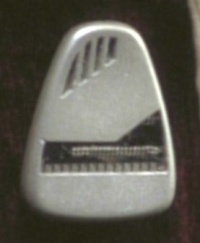Difference between revisions of "Mobile emitter"
m |
|||
| Line 1: | Line 1: | ||
| − | [[Image:Mobileemitter.jpg|thumb| | + | [[Image:Mobileemitter.jpg|thumb|left|200px|Mobile emitter.]] |
| − | + | Officially known as the "autonomous self-sustaining mobile [[holography|holographic]] emitter" (or simply "mobile emitter") is a piece of [[29th Century]] technology brought back to the [[24th Century]]. <br>It acts as a wholly self-contained [[Holographic Projector|holographic projector]], generating the photons and [[force field]]s necessary to allow a [[hologram]] to exist outside of a [[holodeck]] and physically interact with its environment. | |
| + | |||
| + | |||
| + | Constructed of a poly-deutonic alloy unknown to [[24th Century]] science, the mobile emitter is small enough to fit into the palm of a [[Human]] hand. <br>The emitter is either affixed to the exterior of the active [[hologram|holo-program]] and thereby visible, or it can be covered or enveloped by the program, effectively hiding it from view. | ||
| + | |||
| + | |||
| + | As a '''mobile emitter''' is compatible with 24th century [[Federation]] technology, stored holographic programs (both active and inactive) can be transferred to and from the emitter with ease. | ||
| − | |||
The mobile emitter's internal power source can also interact with a variety of other technologies to function as an impromptu battery. | The mobile emitter's internal power source can also interact with a variety of other technologies to function as an impromptu battery. | ||
| − | [[Category:Engineering]] | + | |
| + | During the 24th century, the mobile emitter was used almost exclusively for use by [[USS Voyager]]'s [[EMH]] program, [[The Doctor]]. | ||
| + | |||
| + | |||
| + | |||
| + | ''See also'': | ||
| + | * [[Duck blind]] | ||
| + | * [[Emergency Medical Hologram]] | ||
| + | * [[Holodeck]] | ||
| + | * [[Hologenerator]] | ||
| + | * [[Holosuite]] | ||
| + | * [[Isolation suit]] | ||
| + | * [[Particle synthesis]] | ||
| + | |||
| + | |||
| + | <br> | ||
| + | |||
| + | |||
| + | [[Category: Engineering]] | ||
[[Category: Starship Systems]] | [[Category: Starship Systems]] | ||
[[Category: Holographics]] | [[Category: Holographics]] | ||
Revision as of 02:33, 1 March 2024
Officially known as the "autonomous self-sustaining mobile holographic emitter" (or simply "mobile emitter") is a piece of 29th Century technology brought back to the 24th Century.
It acts as a wholly self-contained holographic projector, generating the photons and force fields necessary to allow a hologram to exist outside of a holodeck and physically interact with its environment.
Constructed of a poly-deutonic alloy unknown to 24th Century science, the mobile emitter is small enough to fit into the palm of a Human hand.
The emitter is either affixed to the exterior of the active holo-program and thereby visible, or it can be covered or enveloped by the program, effectively hiding it from view.
As a mobile emitter is compatible with 24th century Federation technology, stored holographic programs (both active and inactive) can be transferred to and from the emitter with ease.
The mobile emitter's internal power source can also interact with a variety of other technologies to function as an impromptu battery.
During the 24th century, the mobile emitter was used almost exclusively for use by USS Voyager's EMH program, The Doctor.
See also:
- Duck blind
- Emergency Medical Hologram
- Holodeck
- Hologenerator
- Holosuite
- Isolation suit
- Particle synthesis
